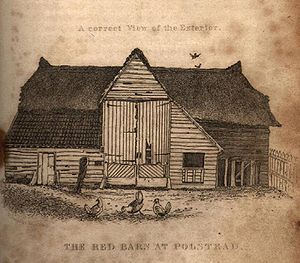Polstead
| Polstead | |
|---|---|
 Church of St Mary, Polstead | |
| Population | 808 |
| OS grid reference | TL991374 |
| District | |
| Shire county | |
| Region | |
| Country | England |
| Sovereign state | United Kingdom |
| Post town | COLCHESTER |
| Postcode district | CO6 |
| Dialling code | 01206 |
| Police | Suffolk |
| Fire | Suffolk |
| Ambulance | East of England |
| UK Parliament | |
Polstead is a village and civil parish in Babergh, Suffolk, England. In 2001 there were 808 people living in Polstead.[1] It is famous for the Red Barn Murder that happened there in 1827. It includes the hamlets of Mill Street, Polstead Heath, Hadleigh Heath, Bower House Tye and Whitestreet Green.[2]
Red Barn Murder
[change | change source]
The Red Barn Murder was a murder (killing) that happened in Polstead in 1827. A man named William Corder shot his lover, Maria Marten. The Red Barn was a local landmark. Marten and Corder were going to meet at the barn and then elope to (run away and get married) Ipswich.[3] Corder ran away to London and married another woman. He sent Marten's family letters that said that Maria was happy and healthy.
Maria Marten's mother had dreams about the murder. In the dreams, Maria's ghost pointed to where she was buried in the barn. On April 19, 1828, Maria's body was found in a sack (a bag) in a bin for holding grain. The London police found Corder and arrested him. They also found two pistols that he had bought the day of the murder.[4]
The trial started on August 7, 1828. It was held at Shire Hall in Bury St Edmunds. William Corder was charged with killing Maria Marten by shooting and stabbing her.[3] He was also charged with forgery. There were a total of 9 charges. He pleaded not guilty.
The jury deliberated for only 35 minutes. (Deliberating is when the people in the jury talk and try to decide if the person is guilty or not guilty.) Corder was found guilty.[5] He was sentenced to death by hanging. The judge ordered that after he was dead his body was to be dissected.
William Corder died on August 11, 1828 just before noon. He was hanged at the gallows in Bury St Edmunds. Many people showed up to see him die. One newspaper said there were 7,000 people who showed up. Another newspaper said there were 20,000.[6] After he was dead, the body was taken back to the courtroom. More than 5,000 people came to the courtroom to see Corder's body.[7] His body was dissected the next day. His skeleton was put on display in the Hunterian Museum at the Royal College of Surgeons of England. In 2004, it was taken down and cremated.[8]
References
[change | change source]- ↑ "Area: Polstead CP (Parish)". 2001 Census: Key Statistics. Office for National Statistics, United Kingdom. 28 April 2004. Archived from the original on 2016-03-05. Retrieved 2011-08-17.
- ↑ "» Polstead The Quintessential Suffolk Village". polstead.onesuffolk.net.
- ↑ 3.0 3.1 Smith, John Hay (1847). Celebrated Trials of All Countries, and Remarkable Cases of Criminal Jurisprudence. J.Harding.
- ↑ "The Red Barn Murder". St Edmundsbury Council. Archived from the original on 21 March 2004. Retrieved 15 February 2007.
- ↑ Urban, Sylvanus (1828). "Domestic Occurrences". The Gentleman's Magazine. 98 (21). London: J.B Nichols.
- ↑ Gatrell, V.A.C. (1996). The Hanging Tree: Execution and the English People, 1770–1868. Oxford Paperbacks. p. 13. ISBN 978-0-19-285332-5.
- ↑ Curtis, James (1828). The Mysterious Murder of Maria Marten. London: William Clowes. p. 210.
- ↑ "Killer cremated after 180 years". BBC News. 17 August 2004. Retrieved 4 July 2007.
